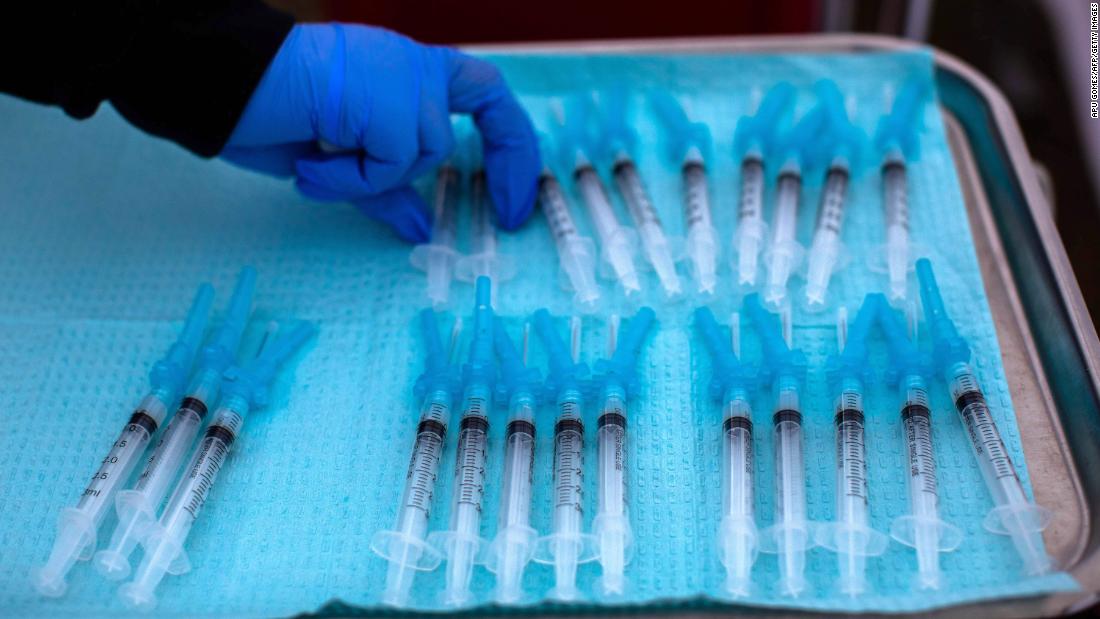“I spoke to all the pharmaceutical companies and scientists, and they all say the same thing: even if these vaccines decrease a little, they will be able to update them continuously,” said Slavitt, responsible for Covid’s response, to CNN. Chris Cuomo on Thursday.
The United States has witnessed a 26% decline in new cases since last week, continuing the trend of more pronounced decline in new cases since the start of the pandemic, according to data from Johns Hopkins University.
Authorities have rushed to administer vaccines quickly to anticipate new mutations, with about 57.7 million doses administered so far across the country, according to the CDC.
New research in Israel and Canada found that only a single dose of the Pfizer / BioNTech vaccine offers significant protection against the virus, but Slavitt said that does not mean that people should avoid the second injection.
“We don’t know how long or how long this benefit is without the boost,” he said. “We don’t know how effective it is against variants.”
The US will have to work “twice as hard” after the winter
“It was slowed down; in some places it is paralyzed,” said Fauci, the country’s leading infectious disease specialist, in an interview with MSNBC on Thursday.
Several states have reported delays in vaccine delivery and distribution, forcing providers to cancel or reschedule vaccination appointments. The Federal Emergency Management Agency (FEMA) said on Thursday that more than 2,000 vaccination sites are in areas suffering from power outages.
Fortunately, none of the vaccines that need to be stored at specific temperatures were spoiled this week to the authorities’ knowledge, said Slavitt.
Houston, hit by power cuts and water problems during the storm, plans to resume vaccination on Saturday and Sunday, the city’s health department said in a statement on Thursday.
Many states hit at the start of storms, particularly Texas, had to cancel vaccination schedules due to dangerous road conditions and power outages.
But Connecticut Governor Ned Lamont said on Thursday that so far the state has not had to make any cancellations.
“Look, there are interruptions,” said Lamont. “Fortunately, we have almost all of our doses for this week and so far so good, no cancellation is planned, but time will tell.”
Black and Hispanic people are getting fewer vaccines
The World Health Organization will issue a new statement on Friday, focusing on vaccine equality, Director-General Tedros Adhanom Ghebreyesus said during a news conference on Thursday.
Although Tedros’ statement focuses on vulnerable groups and small island states with less bargaining power than larger countries, inequality was once a factor in the United States.
Researchers at the Kaiser Family Foundation (KFF) analyzed data at the state level for the 34 states that collected demographic information about Covid-19 vaccinations on February 16.
In most of these states, blacks and Hispanics received smaller portions of vaccines compared to their proportions of cases, deaths and percentage of the population, the researchers noted. The opposite is true for white people in most states.
In Texas, for example, Hispanics account for 42% of coronavirus cases, 47% of Covid-19 deaths and 40% of the state’s population – but they received only 20% of vaccinations.
Among the 27 states that report ethnicity data for those who received at least one dose of the vaccine, whites were vaccinated at a rate three times higher than Hispanics and twice more than blacks.
The KFF team noted that some states do not record the race or ethnicity of those vaccinated.
Researchers found higher infection rate in pregnant women
The infection rate in pregnant women in the study was 13.9 in every 1,000 births, compared with an overall rate of 7.3 in 1,000 for people aged 20 to 39 in the state.
The higher infection rates “may be due to over-representation of women in many professions and sectors deemed essential during the COVID-19 pandemic – including health, education, service sectors,” said lead author Dr. Erica Lokken in a press release.
“Pregnant women are excluded from the prioritization of allocation in about half of the states in the US. Many states are not even linking their COVID-19 vaccine allocation plans to the high-risk medical conditions listed by [Centers for Disease Control and Prevention] “Which include pregnancy,” said Waldorf.
A Pfizer / BioNTech vaccine trial for pregnant women gave their first participants doses on Thursday. Doses were administered to participants in the United States, although the trial is conducted in nine countries: the United States, Canada, Argentina, Brazil, Chile, Mozambique, South Africa, the United Kingdom and Spain.
The company said the trial aims to evaluate the vaccine in pregnant women, but also in their babies, who will be monitored for safety and the transfer of potentially protective antibodies up to 6 months of age.
Pfizer / BioNTech also hopes to expand testing for children aged 5 to 11 in the next two months, according to a company press release.
CNN’s Christina Maxouris, Dakin and one, Michael Nedelman, Deidre McPhillips, Andrea Diaz, Keith Allen, Mirna Alsharif, Naomi Thomas and Amanda Sealy contributed to this report.
